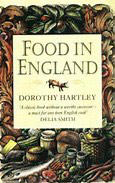Beef cheese
‘Beef cheese’ from Food in England by Dorothy Hartley is an uncharacteristically complicated potted food and a good one. The book appeared in 1954 and has become a celebrated celebration of a nation’s traditional foodways. Her evocative Food in England includes invaluable recipes but to describe it as a cookbook would be something like calling Moby Dick a treatise on whales. Idiosyncratic as well as encyclopedic, and illustrated with captivating drawings by the author, for sheer bravura nothing rivals Food in England other than Isobel Christian Johnstone’s romp through Regency Scotland.
“Take three parts beef to one part bacon or ham and half a part good rendered beef suet. Mince all these together, mixing well, and seasoning strongly with black pepper, salt, a little powdered clove, and some well-dried thyme (this last is important for the flavour, but it should be well dried and powdered; no green herbs should be used).”
The historical context embedded within the recipe is typical of the meticulous Hartley:
“The old recipes instruct you to moisten the whole with good brandy (which dates the dish to sailing-ship days), yet for modern usage substitute Worcestershire sauce, but keep the mixture dry as the suet and fat from the ham will bind sufficiently when heated. Now rub the tin over with cut garlic, and grease it; then take a few rashers of fat bacon and cut them into strips which interlace the sides and bottom of the baking tin; press the mixture into it (taking care not to disturb the lattice of bacon strips), pack it down tightly, and cover closely with a paste made of flour and water, sealing the edges. Bake it steadily for 5 or 6 hours, and allow it to grow cold in the oven.”
Why leave the pot in the oven to cool? As Hartley explains,
“the point is not to move or stir the dish till it has set cold and sealed itself in the sterile air of the oven, thus preventing any bacteria getting under the crust while soft and porous.
When withdrawn cold, the sealing crust will have sunk down close over the meat and any interstices will be closed with clarified suet melted into them.
When the pot is constructed the way Hartley instructs, the bacon adds visual as well as gustatory appeal:
“The ‘huff’ or sealing paste should be removed and the beef inverted for serving--the lattice of bacon strips is very decorative and the ‘cheese’ cuts in firm slices.” (Hartley 346-47)
There it is, a complex process lucidly described with an explanation for the otherwise puzzling aspects of the recipe.

Notes:
-“This was a ship’s store--it probably went to America on the Mayflower.” (Hartley 246) The required long, long shelf life explains the admonition against the use of fresh green herbs.
-The brandy would give an altogether different tint to the flavor palette of the pot and is worth trying notwithstanding the lure of the always welcome Worcestershire.
-Note the early English use of garlic in contradistinction to conventional wisdom.
-The inedible pasty sealant serves a purpose other than preservation. It concentrates the flavor of the pot in the same way as the (decidedly edible) suet pastry of a streamed pudding bosts the flavor of its filling whether savory or sweet.
